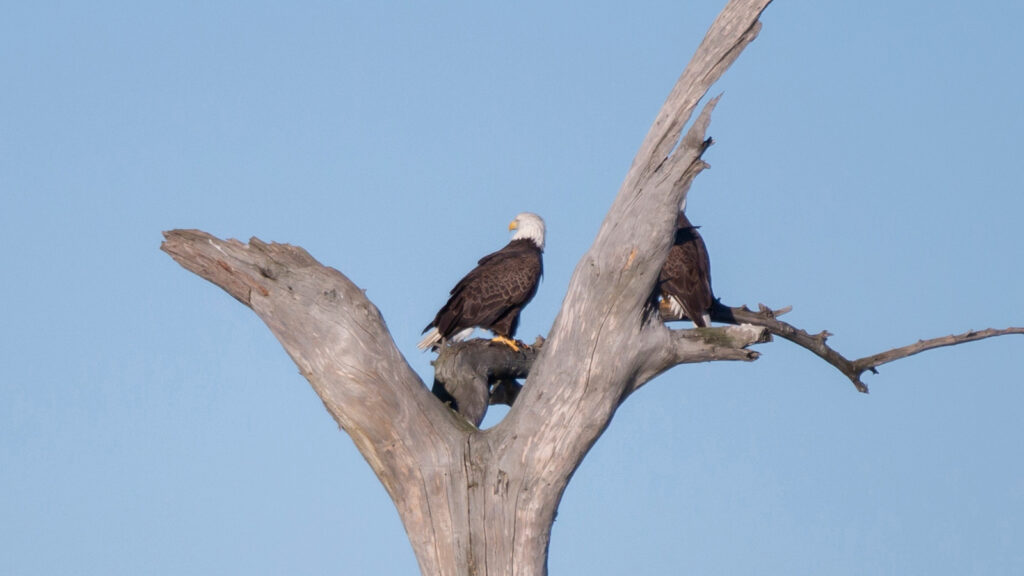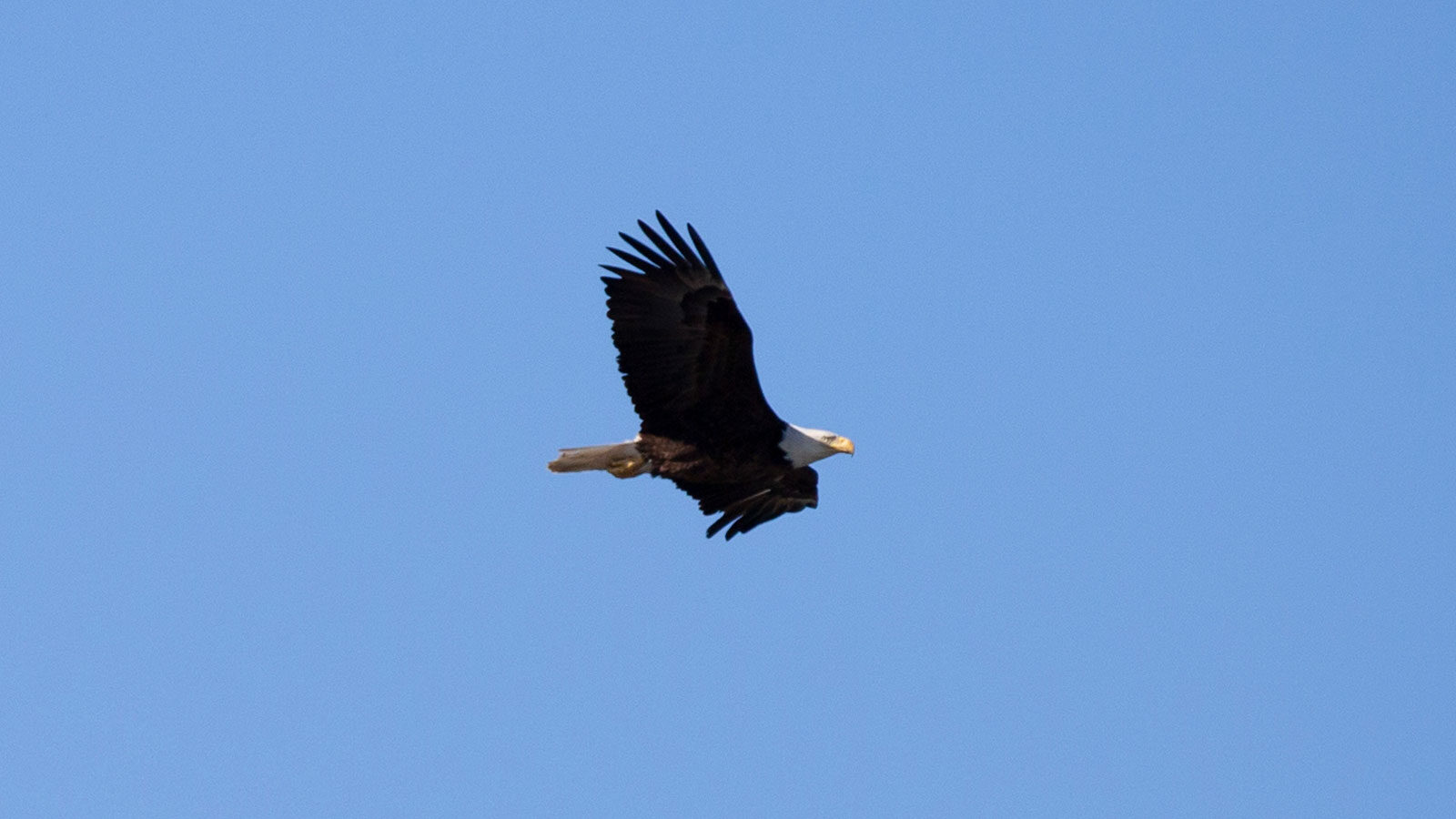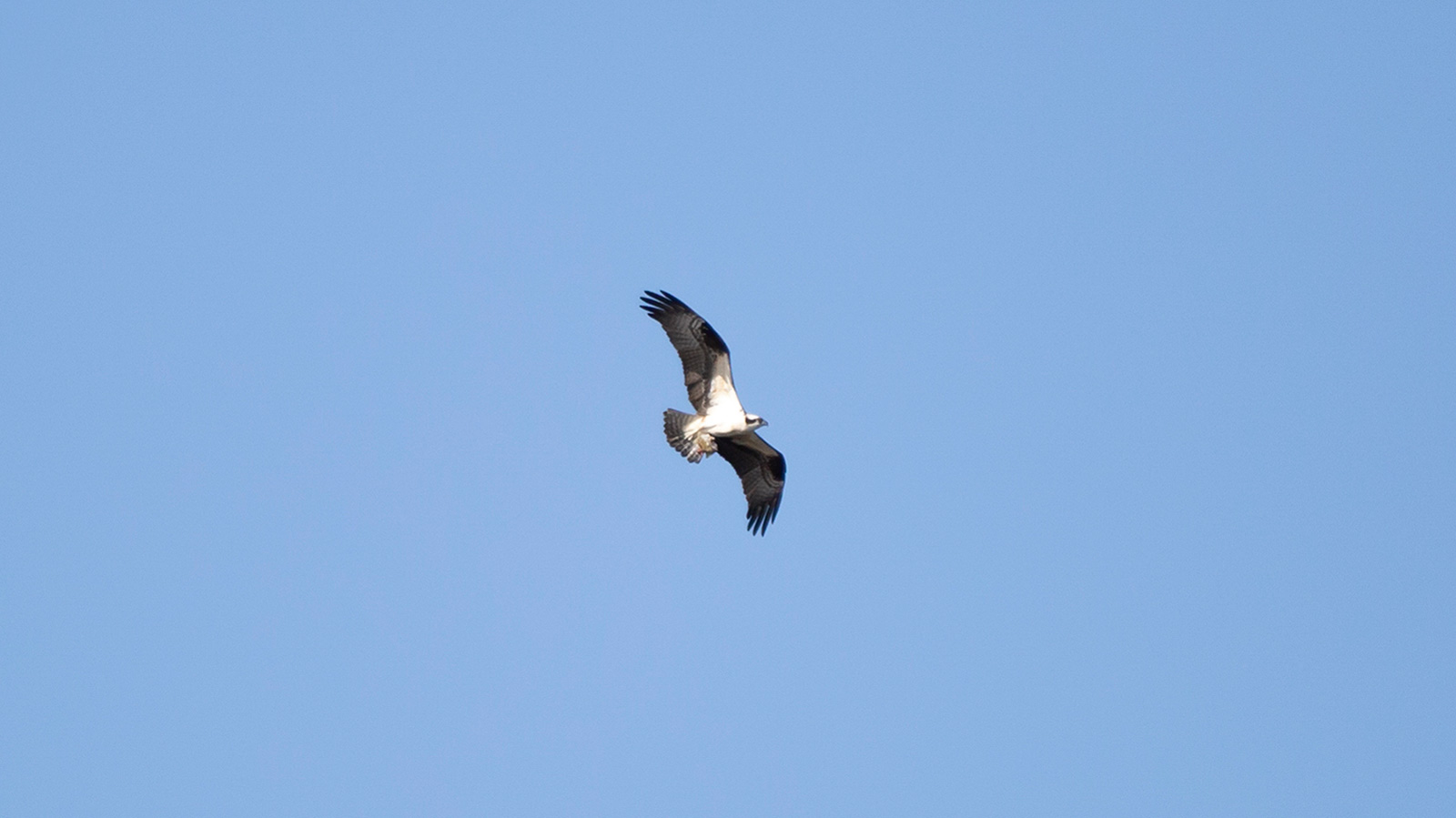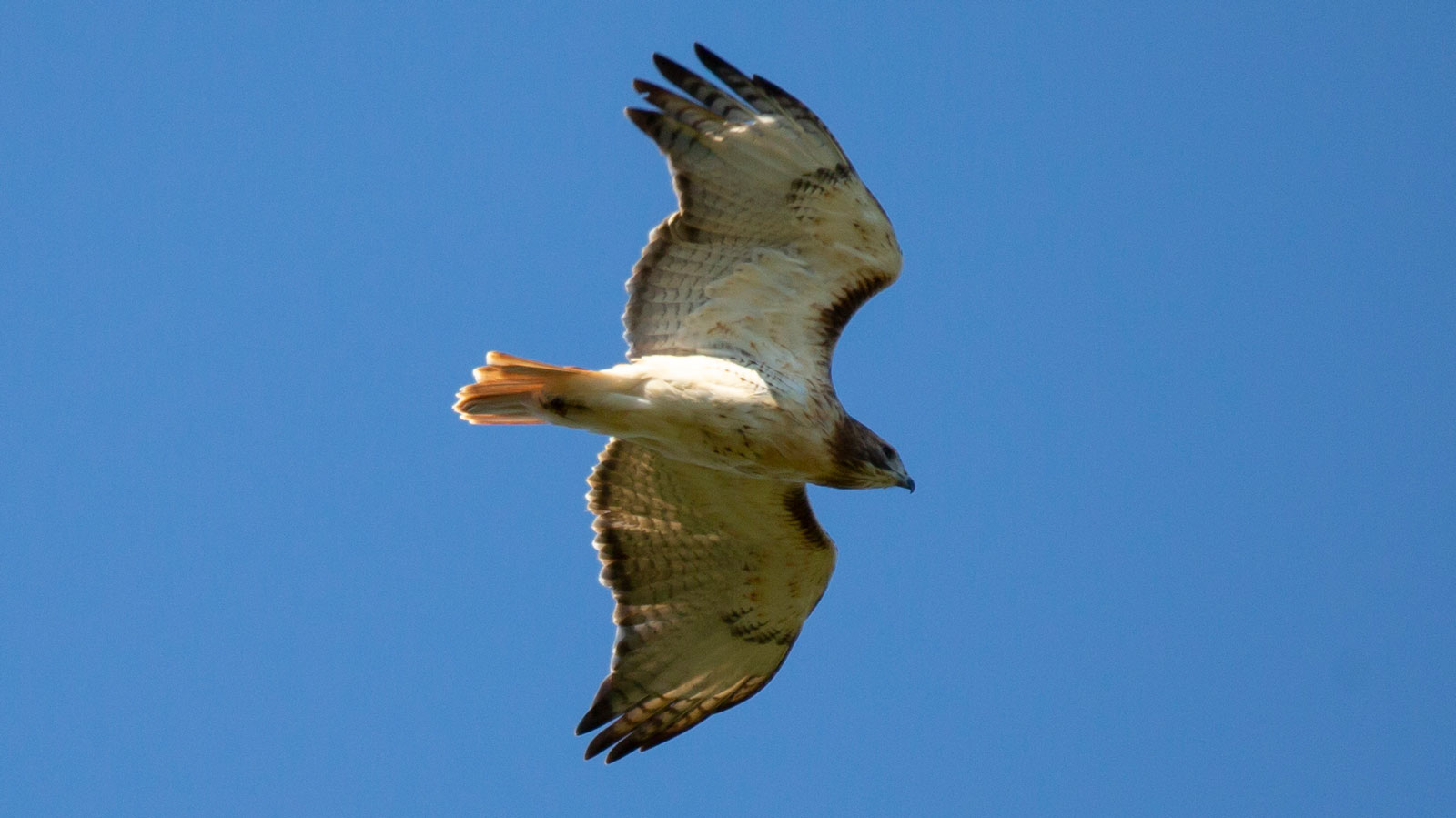
Did you know that Louisiana is home to nearly 1000 nesting pairs of bald eagles?
Bald Eagles
at
a Glance

Key Features:
Adult bald eagles are large brown bodied birds with white heads and tails, yellow beaks and legs, large talons that can snatch small mammals and fish up and carry them wriggling through the air. Young bald eagles have the same body shape and a mottled brown body, and chicks are gray.
Conservation Status: Least Concern - Population Increasing
Habitat:
Lakes, reservoirs, and rivers surrounded by forests
nesting habits:
Bald eagles are monogamous breeders who build nests of sticks, feathers, and lichen high in trees.
seasons bald eagles are active in our area:
All year
Diet:
Fish, birds, and small mammals
hunting Behavior:
Bald eagles are solitary hunters with fantastic eye sight who can hunt in flight, from a perch, while wading in water, or on the ground. Bald eagles will swoop down and scoop up small mammals, and, more commonly fish.
commonly confused with:
Black Vultures, Turkey Vultures, and Golden Eagles


Bald eagles are often confused with ospreys due to their shared fishing habits and their white heads.
Young bald eagles are often confused with red-tailed hawks because of similar coloration.
ABOUT BALD EAGLES
The bald eagle is 1 of more than 60 species of eagles that live on 6 continents and 1 of only 2 species that roam the skies of North America (along with the less frequently seen golden eagle). The bald eagle is a sea eagle belonging to the Accipitridae family, which also includes harriers, hawks, and kites. It is so similar to hawk species that 18th-century naturalist Carl Linnaeus described it as a white-headed falcon.
You can spot bald eagles throughout most of Canada, the U.S., and northern Mexico.
You can find bald eagles perched on tall trees or soaring above meadows at North Louisiana lakes and wetland areas year-round. In the spring, the birds nest high in the trees deep in our lakes and swamps, where open water provides the best fishing opportunities. Our favorite spots to watch bald eagles are the Poverty Point Reservoir State Park and D’Arbonne National Wildlife Refuge. You can also find them at Lake Claiborne and the Black Bayou Lake National Wildlife Refuge.
Because of our temperate climate, bald eagles hang out in North Louisiana year-round. You’ll likely spot more eagles in North Louisiana during the fall and winter when they migrate south from the uppermost part of their range.
Bald eagles are diurnal. You’ll spot these expert anglers during the day for much of the year, but when daytime temps start frying chicken, they become nocturnal.
An adult bald eagle is identifiable by its iconic white head and tail and solid brown body. The bird you’re most likely to confuse with an adult bald eagle is the osprey, a slightly smaller bird with a mostly white head and underbelly who also fishes, particularly on lakes. You can generally identify an osprey by the brown streak running from the back of its neck to its eye, white underbelly, black beak (as opposed to the bald eagle’s yellow one), and white feet.
It is easy to confuse an immature bald eagle with a red-tailed or red-shouldered hawk or a golden eagle because of its brown head. You can identify an immature bald eagle by its yellow irises, yellow feet, and white streaks in the body, which will become less pronounced as it ages, or by its behavior. It is easy to confuse an immature bald eagle with a red-tailed or red-shouldered hawk or a golden eagle because of its brown head. The hawks and golden eagle primarily hunt in forests and over open fields, whereas the bald eagle mostly hunts over open water.
While mature bald eagles have a unique hairstyle, wildlife enthusiasts often mistake the brown-headed immature bald eagles for hawks and golden eagles. Immature bald eagles have larger heads and larger, yellow-tipped beaks than golden eagles and hawks. The golden eagle is a warmer brown than an immature bald eagle, while hawks like the red-tail are deeper brown. If the bird is fishing, it’s over open water, it’s most likely an immature bald eagle. The golden eagle is primarily a wintertime visitor who you might encounter in forested areas as it hunts for small mammals.
A bald eagle uses calls to communicate it’s looking for a mate, the chicks are hungry, or the nest is in danger. Most bald eagle calls are high-pitched, chirpy sounds resembling those of smaller birds like kites and gulls. Its TV-famous scream belongs to its cousin, the red-tailed hawk. The eagle’s alarm or “peal” call is similar to a kite’s hunting call, like someone swinging a rusty gate open and shut. Other adult calls include a staccato, chirping whistles, and clicking sounds.
Like other birds, a baby eagle is born with a one-note song to tell its parents it’s hangry, and if they don’t return with food soon enough, it attacks its siblings. The young bird learns more calls from its parents and sounds similar to an adult eagle about a month after birth.
Although the bald eagle’s main course is generally fish, it will dine on more than 400 different species of animals, including mammals, reptiles, and even other birds. It is an opportunistic predator and scavenger that will hunt or steal meals, sometimes stealing food that another animal is actively eating. It will even chase and steal lunch from another bald eagle.
It is an expert angler able to spot potential prey from 10,000 feet up to dive quickly and snatch up about a pound of fish per day. It can capture large prey and fly, grasping animals as large as 15 pounds, and will eat ducks when it’s unable to find fish during colder months. It’ll dive at the duck it’s targeted repeatedly until the duck is exhausted. Occasionally, two eagles will split the bill on a large meal, and one will distract it while the other ambushes it from behind.
A bald eagle’s life starts in early spring when it hatches in an eyrie, or platform nest, near the top of a tall tree. The eaglet spends the first few months protected and fed by its parents, growing downy gray feathers and flapping its wings at the edge of the eyrie. By 14 weeks, the eaglet takes its first short flight. It will venture further from the nest until it can hunt on its own and protect itself.
At between 4.5 and 5.5 years old, the eagle grows into its iconic solid white head and tail and begins to search for a mate. Once the eagle finds its mate, the pair will bond through swoops and dives, locking their talons and doing cartwheels through the air together. The female will build the eyrie from materials that the male helps collect. She will lay two or three eggs in late February and start incubating them in March or April. The eaglets will be born roughly a month later.
An eagle will live up to 30 years in the wild, returning to the nest each year, dancing with its mate, and adding more sticks to the old nest until it is six feet high and weighs over a ton. Roughly every five years, the nest will collapse or break, and the building process will start from scratch.
You can listen to bald eagle calls at the Cornell Lab of Ornithology Birds of the World and All About Birds websites and read about their calls at the Vassar University The Gall Lab’s “Bald Eagle (Haliaeetus leucocephalus): Singing Behavior.”
You find out more about the bird at the Audubon Guide to North American Birds, the Kids National Geographic, and The National Wildlife Federation “Bald Eagle” pages, or read about the conservation efforts that have brought the bald eagle back from the brink of extinction at the U.S. Fish and Wildlife Services “History of Bald Eagle Decline, Protection and Recovery” page and learn about nesting sites in Louisana at the Audubon Louisiana’s “Bald eagle numbers rise as hundreds nest in Louisiana” article. You can also read the Bald and Golden Eagle Protection and Migratory Bird Treaty Acts for more information.
Bald Eagles v. Predators
Bald Eagles and Humans
An adult bald eagle is an apex predator with a wingspan up to 7.5 feet and a weight of up to 14 pounds. Because of its size, few animals threaten its nest. Occasionally gulls, crows, red-tailed hawks, owls, other eagles, bobcats, bears, or raccoons will steal eggs from an abandoned nest. However, most young bald eagle deaths are due to collapsing nests, starvation, aggressive siblings, or bad weather.
Because of their violent territorialism and tendency to adapt to bird snacks (even midflight), when the restaurant’s out of other foods, hawks and falcons will mob young bald eagles to prevent them from establishing a territory on their hunting grounds. Occasionally, an eagle will grab a fish that’s large enough to drag them into the water and will drown or catch hypothermia.
In the late 1800s and early 1900s, the bald eagle, or “bird of bad moral character,” as Ben Franklin called it, was hunted by farmers who found the bird eating dead livestock killed by other predators. Farmers also adopted the use of pesticides like DDT that caused the eagle to lay eggs with weak shells that burst under the animal’s weight.
The number of nesting pairs had dropped from about half a million in the 1800s to 400 in the 1950s. Conservation efforts through the latter half of the 1900s included banning DDT pesticides and eagle hunting, improving water quality in lakes and wetlands, and protecting nesting sites. Thanks to efforts including the Bald and Golden Eagle Protection and Migratory Bird Treaty Acts, more than 150,000 nests throughout the continental U.S. today.